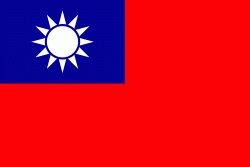New Taiwan dollar
$
The New Taiwan dollar (code: TWD; symbol: NT$, also abbreviated as NT) is the official currency of Taiwan. The New Taiwan dollar has been the currency of Taiwan since 1949, when it replaced the Old Taiwan dollar, at a rate of 40,000 old dollars per one new dollar. The basic unit of the New Taiwan dollar is called a yuan (圓) and is subdivided into ten jiao (角), and into 100 fen (分) or cents, although in practice both jiao and fen are never actually used.There are a variety of alternative names to the units in Taiwan. The unit of dollar is typically informally written with the simpler equivalent character as, except when writing it for legal transactions such as at the bank, when it has to be written as 圓. Colloquially, the currency unit is called both (yúan, literally "circle") and (kuài, literally "piece") in Mandarin, (kho͘, literally "hoop") in Hokkien, and (ngiùn, literally "silver") in Hakka.
The central bank of Taiwan has issued the New Taiwan Dollar since 2000. Prior to 2000, the Bank of Taiwan issued banknotes as the de facto central bank between 1949 and 1961, and after 1961 continued to issue banknotes as a delegate of the central bank. The central bank began issuing New Taiwan dollar banknotes in July 2000, and the notes issued by the Bank of Taiwan were taken out of circulation.
The adjective "new" (新) is only added in formal contexts where it is necessary to avoid any ambiguity, even though ambiguity is virtually non-existent today. These contexts include banking, contracts, or foreign exchange. The currency unit name can be written as 圓 or 元, which are interchangeable. They are both pronounced yuán in Mandarin but have different pronunciations in Taiwanese Hokkien (îⁿ, goân) and Hakka (yèn, ngièn). The name 仙 in Taiwanese Hokkien and Hakka for cent is likely from the hundredth unit 錢 (sen) of Japanese era Taiwanese yen or from English.
In English usage, the New Taiwan dollar is often abbreviated as NT, NT$, or NT dollar, while the abbreviation TWD is typically used in the context of foreign exchange rates. Subdivisions of a New Taiwan dollar are rarely used, since practically all products on the consumer market are sold in whole dollars. Nevertheless, banks do record cents (hundredth of dollar).
Country
-
Taiwan
Taiwan, officially the Republic of China (ROC), is a country Multiple sources:
* in East Asia. It is located at the junction of the East and South China Seas in the northwestern Pacific Ocean, with the People's Republic of China (PRC) to the northwest, Japan to the northeast, and the Philippines to the south. The territories controlled by the ROC consist of 168 islands, with a combined area of 36193 km2. The main island of Taiwan, also known as Formosa, has an area of 35,808 km2, with mountain ranges dominating the eastern two-thirds and plains in the western third, where its highly urbanised population is concentrated. The capital, Taipei, forms along with New Taipei City and Keelung the largest metropolitan area of Taiwan. Other major cities include Taoyuan, Taichung, Tainan, and Kaohsiung. With around 23.9 million inhabitants, Taiwan is among the most densely populated countries in the world.
